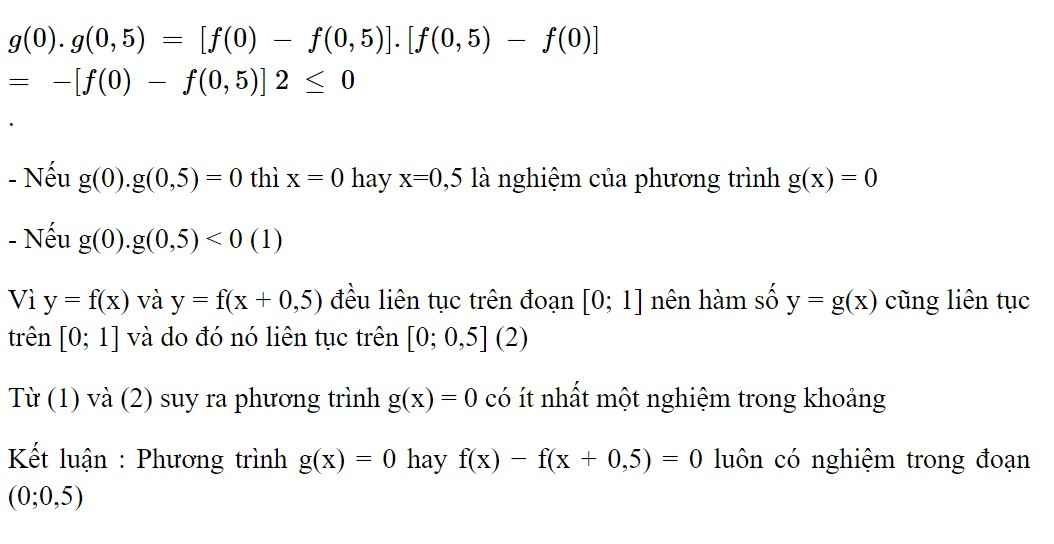Hãy nhập câu hỏi của bạn vào đây, nếu là tài khoản VIP, bạn sẽ được ưu tiên trả lời.

Tham khảo:
Xét hàm số g(x) = f(x) − f(x + 0,5)
Ta có
g(0) = f(0) − f(0 + 0,5) = f(0) − f(0,5)
g(0,5) = f(0,5) − f(0,5 + 0,5) = f(0,5) − f(1) = f(0,5) − f(0)
(vì theo giả thiết f(0) = f(1)).
Do đó,


Bài 2:
a: \(=\dfrac{7}{9}\left(\dfrac{7}{6}-\dfrac{19}{20}-\dfrac{1}{15}\right)+\dfrac{22}{5}\cdot\dfrac{1}{24}\)
\(=\dfrac{7}{9}\cdot\dfrac{3}{20}+\dfrac{22}{120}=\dfrac{7}{60}+\dfrac{11}{60}=\dfrac{18}{60}=\dfrac{3}{10}\)
b: \(=\left(\dfrac{35-32}{60}\right)^2+\dfrac{4}{5}\cdot\dfrac{70-45}{80}\)
\(=\dfrac{1}{400}+\dfrac{4\cdot25}{400}=\dfrac{101}{400}\)

Bài 3. a) cos (x - 1) = ![]() ⇔ x - 1 = ±arccos
⇔ x - 1 = ±arccos![]() + k2π
+ k2π
⇔ x = 1 ±arccos![]() + k2π , (k ∈ Z).
+ k2π , (k ∈ Z).
b) cos 3x = cos 120 ⇔ 3x = ±120 + k3600 ⇔ x = ±40 + k1200 , (k ∈ Z).
c) Vì ![]() = cos
= cos![]() nên
nên ![]() ⇔ cos(
⇔ cos(![]() ) = cos
) = cos![]() ⇔
⇔ ![]() = ±
= ±![]() + k2π ⇔
+ k2π ⇔
.png)
d) Sử dụng công thức hạ bậc ![]() (suy ra trực tiếp từ công thức nhan đôi) ta có
(suy ra trực tiếp từ công thức nhan đôi) ta có
![]() ⇔
⇔ ![]() ⇔
⇔ ![]()
⇔ ![]() ⇔
⇔ ![]()

\(lim\dfrac{\left(n+2\right)^{50}\left(n-3\right)^{80}}{\left(2n-1\right)^{40}\left(3n-2\right)^{45}}=lim\dfrac{\left(1+\dfrac{2}{n^{50}}\right)\left(1-\dfrac{3}{n^{35}}\right)\left(n-3\right)^{45}}{\left(2-\dfrac{1}{n^{50}}\right)\left(3-\dfrac{2}{n^{45}}\right)}=+\infty\)
\(lim\dfrac{4^n}{2.3^n+4^n}=lim\dfrac{1}{2.\left(\dfrac{3}{4}\right)^n+1}=\dfrac{1}{0+1}=1\)
\(lim\dfrac{3^n-2.5^n}{7+3.5^n}=lim\dfrac{\left(\dfrac{3}{5}\right)^n-2}{\dfrac{7}{5^n}+3}=\dfrac{0-2}{0+3}=\dfrac{-2}{3}\)
\(lim\dfrac{4^n-5^n}{2^{2n}+3.5^{2n}}=lim\dfrac{\left(\dfrac{4}{25}\right)^n-\left(\dfrac{1}{5}\right)^n}{\left(\dfrac{2}{5}\right)^{2n}+3}=\dfrac{0-0}{0+3}=0\)
\(lim\dfrac{\left(-3\right)^n+5^n}{2.\left(-4\right)^n+5^n}=lim\dfrac{\left(\dfrac{-3}{5}\right)^n+1}{2.\left(-\dfrac{4}{5}\right)^n+1}=\dfrac{0+1}{0+1}=1\)
1.
Nhớ rằng \(\lim _{x\to \infty}\frac{1}{x}=0\) và \(\lim _{x\to a}\frac{f(x)}{g(x)}=\frac{\lim_{x\to a}f(x)}{\lim_{x\to a}g(x)}\) với \(g(x)\neq 0; \lim_{x\to a}g(x)\neq 0\)
Do đó:
\(\lim_{n\to \infty}\frac{(n+2)^{50}.(n-3)^{80}}{(2n-1)^{40}.(3n-2)^{45}}=\lim_{n\to \infty}\frac{n^{130}(\frac{n+2}{n})^{50}.(\frac{n-3}{n})^{80}}{n^{85}(\frac{2n-1}{n})^{40}.(\frac{3n-2}{n})^{45}}\)
\(=\lim_{n\to \infty}\frac{n^{45}(1+\frac{2}{n})^{50}(1-\frac{3}{n})^{80}}{(2-\frac{1}{n})^{40}.(3-\frac{2}{n})^{45}}\)
\(=\frac{\lim_{n\to \infty}[n^{45}(1+\frac{2}{n})^{50}(1-\frac{3}{n})^{80}]}{\lim_{n\to \infty}[(2-\frac{1}{n})^{40}.(3-\frac{2}{n})^{45}]}\)
\(=\frac{\lim_{n\to \infty}n^{45}.1^{50}.1^{80}}{2^{40}.3^{45}}=\frac{\infty}{2^{40}.3^{45}}=\infty\)

\(\lim\limits_{x\rightarrow1}\dfrac{x^3-3x+2}{x^4-4x+3}=\lim\limits_{x\rightarrow1}\dfrac{\left(x+2\right)\left(x-1\right)^2}{\left(x^2+2x+3\right)\left(x-1\right)^2}=\lim\limits_{x\rightarrow1}\dfrac{x+2}{x^2+2x+3}=\dfrac{1}{2}\)
\(\lim\limits_{x\rightarrow2^-}\dfrac{x^3+x^2-4x-4}{x^2-4x+4}=\lim\limits_{x\rightarrow2^-}\dfrac{\left(x-2\right)\left(x^2+3x+2\right)}{\left(x-2\right)^2}=\lim\limits_{x\rightarrow2^-}\dfrac{x^2+3x+2}{x-2}=-\infty\)
\(\lim\limits_{x\rightarrow2}\dfrac{\left(x^2-x-2\right)^{20}}{\left(x^3-12x+16\right)^{10}}=\lim\limits_{x\rightarrow2}\dfrac{\left(x+1\right)^{20}\left(x-2\right)^{20}}{\left(x+4\right)^{10}\left(x-2\right)^{20}}=\lim\limits_{x\rightarrow2}\dfrac{\left(x+1\right)^{20}}{\left(x+4\right)^{10}}=\dfrac{3^{10}}{2^{10}}\)
\(\lim\limits_{x\rightarrow0^-}\dfrac{4x^2+5x}{x^2}=\lim\limits_{x\rightarrow0^-}\dfrac{4x+5}{x}=-\infty\)
\(\lim\limits_{x\rightarrow-1}\dfrac{\sqrt{x+2}-1}{\sqrt{x+5}-2}=\lim\limits_{x\rightarrow-1}\dfrac{\left(x+1\right)\left(\sqrt{x+5}+2\right)}{\left(x+1\right)\left(\sqrt{x+2}+1\right)}=\lim\limits_{x\rightarrow-1}\dfrac{\sqrt{x+5}+2}{\sqrt{x+2}+1}=2\)


a: \(0,75< 1\)
=>Hàm số \(y=0,75^x\) nghịch biến trên R
mà -2,3>-2,4
nên \(0,75^{-2,3}< 0,75^{-2,4}\)
b: \(\dfrac{1}{4}< 1\)
=>Hàm số \(y=\left(\dfrac{1}{4}\right)^x\) nghịch biến trên R
mà 2023<2024
nên \(\left(\dfrac{1}{4}\right)^{2023}>\left(\dfrac{1}{4}\right)^{2024}\)
c: Vì 3,5>1
nên hàm số \(y=3,5^x\) đồng biến trên R
mà 2023<2024
nên \(3,5^{2023}< 3,5^{2024}\)